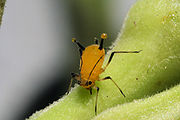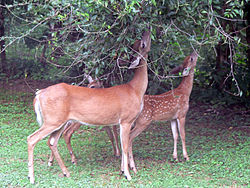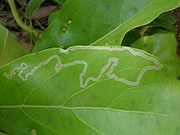
Herbivore
Background to the schools Wikipedia
This wikipedia selection has been chosen by volunteers helping SOS Children from Wikipedia for this Wikipedia Selection for schools. SOS Child sponsorship is cool!
Herbivory is a form of predation in which an organism, known as a herbivore, consumes principally autotrophs such as plants, algae and photosynthesizing bacteria. By that definition, many fungi, some bacteria, many animals, some protists and a small number of parasitic plants can be considered herbivores. However, herbivory is generally restricted to animals eating plants. Fungi, bacteria and protists that feed on living plants are usually termed plant pathogens. Microbes that feed on dead plants are saprotrophs. Flowering plants that obtain nutrition from other living plants are usually termed parasitic plants. More generally, organisms that feed on autotrophs in general are known as primary consumers.
Herbivores
A herbivore is an animal that is adapted to eat primarily plant matter (rather than meat). Although such animals are sometimes referred to as being vegetarian, this term is more properly reserved for humans who choose not to eat meat as opposed to animals that are unable to make such choices. The diets of some herbivorous animals vary with the seasons, especially in the temperate zones, where different plant foods are most available at different times of year.
There is a misperception that if an animal is herbivorous, it represents less danger to humans than a carnivore (or, sometimes, no danger at all). This is not logically sound; few animals, even carnivores, will seek humans as a food source, but any animal will attack a human if necessary to defend itself. For example, in national parks such as the United States' Yellowstone Park, bison represent significantly more danger to humans than wolves, which are likely to avoid people. Of Africa's Big Five game (a term coined by hunters in Africa to refer to the five most dangerous animals to hunt: Rhinoceros, Leopard, Cape Buffalo, Elephant and Lion), three are herbivores.
Herbivores form an important link in the food chain as they transform the sun's energy stored in the plants to food that can be consumable by carnivores and omnivores up the food chain. As such, they are termed the primary consumers in the food chain.
Feeding strategies
Herbivores differ in the extent, specificity and nature of their feeding.
They can be grouped according to which part of the plant they eat: frugivores which eat mainly fruit; folivores, which specialize in eating leaves; nectarivores, which feed on nectar; among herbivorous insects and other arthropods, the level of feeding specialization can be far more fine-tuned, including seed-eaters (" granivores"), pollen-eaters (" palynivores"), plant fluid-feeders (" mucivores"), and those specialized to feed on wood (" xylophages") or roots (" rhizophages"). In other animals, the degree of specialization is not so advanced, however, and many fruit- and leaf-eating animals also eat other parts of plants, notably roots and seeds.
The techniques used to get at the foodstuff are wide and varied, and include the "pierce and suck" technique, surface fluid feeding, hole feeding, margin feeding and skeletonisation.
Evolution of herbivory
Our understanding of herbivory in geological time comes from three sources: fossilised plants, which may preserve evidence of defence (such as spines), or herbivory-related damage; the observation of plant debris in fossilised animal faeces; and the construction of herbivore mouthparts.
Long thought to be a Mesozoic phenomenon, evidence for herbivory is found almost as soon as fossils which could show it. Within under 20 million years of the first fossils of sporangia and stems towards the close of the Silurian, around 420 million years ago, there is evidence that they were being consumed. Animals fed on the spores of early Devonian plants, and the Rhynie chert also provides evidence that organisms fed on plants using a "pierce and suck" technique.
During the ensuing 75 million years, plants evolved a range of more complex organs - from roots to seeds. There is no evidence for these being fed upon until the middle-late Mississippian, 330.9 million years ago. There was a gap of 50 to 100 million years between each organ evolving, and it being fed upon; this may be due to the low levels of O2 during this period, which may have suppressed evolution. Further than their arthropod status, the identity of these early herbivores is uncertain. Hole feeding and skeletonisation are recorded in the early Permian, with surface fluid feeding evolving by the end of that period.
Arthropods have evolved herbivory in four phases, changing their approach to herbivory in response to changing plant communities.
Plant defences
Plant defence against herbivory include a range of adaptations evolved by plants to improve their survival and reproduction by reducing the impact of animals that eat them. Plants have evolved an enormous array of mechanical and chemical defences against herbivores.
These defences include mechanical protections on the surface of the plant, production of complex polymers that reduce plant digestibility to animals, and the production of toxins that kill or repel herbivores. Defenses can either be constitutive, always present in the plant, or induced, produced or translocated by the plant following damage or stress. The term host plant resistance is also used by plant breeders to refer to these mechanisms.
Plants have also evolved features that enhance the probability of attracting natural enemies to herbivores. Specifically, they emit semiochemicals, odours that attract natural enemies, and provide food and housing to maintain the natural enemies’ presence.
A given plant species often has many types of defensive mechanisms, mechanical or chemical, constitutive or induced, which additively serve to protect the plant, and allow it to escape from herbivores.
In some cases, herbivory is actually encouraged by plants to assist in reproduction. A notable example is the production of nectar to attract bees, which are necessary for pollination.
Herbivore adaptations to defences

Herbivores are dependent on plants for food, and have coevolved mechanisms to obtain this food despite the evolution of a diverse arsenal of plant defenses against herbivory. Herbivores adaptations to plant defense have been likened to “offensive traits” and consist of those traits that allow for increased feeding and use of a host. Plants, on the other hand, protect their resources for use in growth and reproduction, by limiting the ability of herbivores to eat them. Relationships between herbivores and their host plants often results in reciprocal evolutionary change. When a herbivore eats a plant it selects for plants that can mount a defensive response, whether the response is incorporated biochemically or physically, or induced as a counterattack. In cases where this relationship demonstrates “specificity” (the evolution of each trait is due to the other), and “reciprocity” (both traits must evolve), the species are thought to have coevolved. The escape and radiation mechanisms for coevolution, presents the idea that adaptations in herbivores and their host plants, has been the driving force behind speciation.



